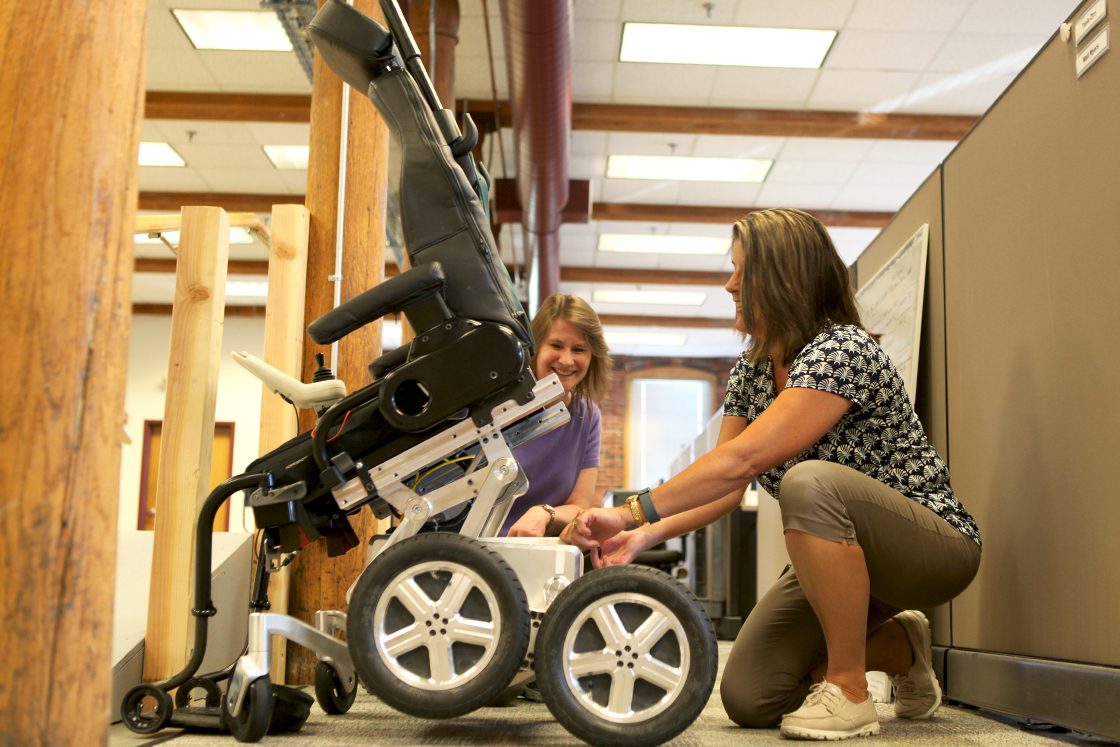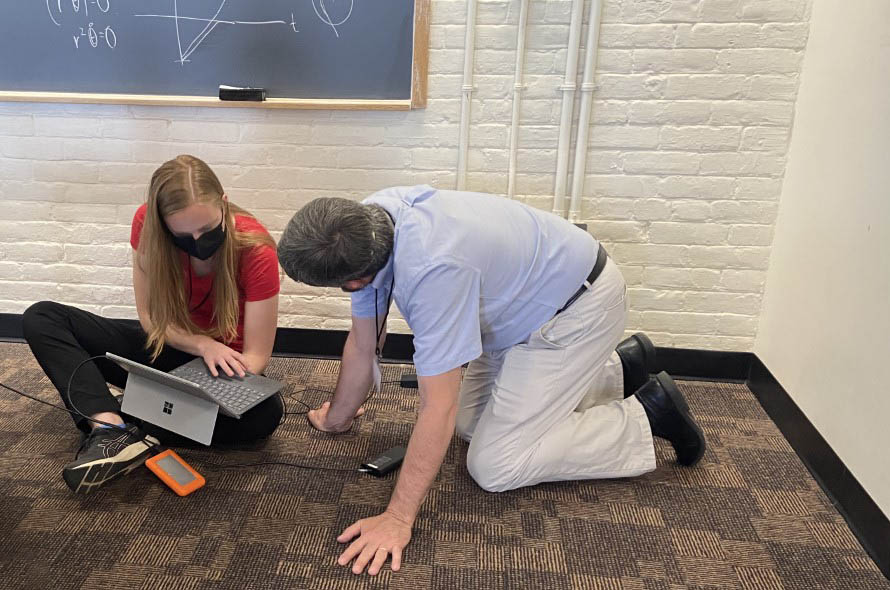Self-Promotion and Advocacy Provide Industry with the Mathematicians That It Needs
I have spent 22 years at DEKA Research and Development, a company that uses science and engineering to measurably improve people’s lives. The corporation has worked on projects that relate to dialysis, clean water, mobility for individuals who rely on wheelchairs, prosthetics, and regenerative medicine. During my time with DEKA, I have hired four mathematicians — all of whom have been exceptional. The first was an undergraduate student at Brown University who employed random forests to solve a particularly knotty problem that utilized diagnostic test data to improve predictions of pulmonary embolisms. His solution allowed us to create a test for which physicians previously had to rely on conflicting and non-specific data.
The second mathematician was a summer intern from Worcester Polytechnic Institute who developed the signal processing algorithm for a tabletop magnetic resonance imaging (MRI) demonstrator. He later secured a permanent position at DEKA and spent his time investigating closed-loop physiological control, image processing, and medical safety systems. With no experience writing embedded code, this individual succeeded admirably on each task.
After completing his undergraduate degree at Southern New Hampshire University, my third mathematician joined our delivery robot program’s path planning team and investigated optimal robot routing. Although he had never before written embedded code in C, his grasp of path planning’s fundamental elements, ability to clearly explain ideas, and unique set of solutions were all invaluable. This employee quickly mastered the necessary programming skills and now leads the path planning team.

The most recent mathematician that I hired holds a Ph.D. from the University of Michigan. She has made fundamental improvements to our analysis of test data—despite having no prior experience in this realm—and delivered a talk earlier this year to describe her methods to the test group. She also reexamined and improved DEKA’s application of Kalman filters to a medical sensing system, considered alternate optimal predictive filters, and investigated model predictive control for a physiological device. Most recently, she thoroughly explored the physics of diffusion and how to best align experimental results with the governing equations, again explaining her results in a company-wide talk.
The mathematicians possess remarkable flexibility when approaching and understanding complex problems. Their solutions are unique, and they are not afraid to seek answers in disciplines that are not traditionally associated with the problem in question. Furthermore, the level of rigor that they apply to their work is vital for success — certainly in medical products but also in any industry where resources are limited, customers are demanding, or failure is disastrous. Another valuable quality among mathematicians is their absolute fearlessness when facing new challenges. Graduate study certainly equips mathematicians with the confidence that they can eventually solve a problem by studying it and examining previous work. I believe that these traits are not exclusive to the mathematicians with whom I have been fortunate to work, but are instead fundamental elements of how mathematicians are taught to think.
Given these sterling qualities, why don’t companies hire more mathematicians? In my opinion, mathematicians’ fatal flaw is underselling themselves to industry. DEKA is one of the rare businesses that does not depend on the automated scanning of resumes; instead, our recruiters send me the resumes of mathematicians and other applicants with odd but interesting backgrounds. Because I am a mathematician myself, I can appreciate the value of these individuals. But their resumes are typically sparse, often providing only a thesis title and maybe a list of classes that they’ve taught.
Most businesses scan resumes for keywords that indicate an applicant’s compatibility with some elements of the job description. It is thus essential that candidates carefully read the job description and echo its wording. Early-career mathematicians should also learn how to appreciate and articulate the way in which their academic background allows them to contribute to the target areas.
As a discipline, we must ensure that new mathematicians understand the questions that drive other fields and recognize their own capability to answer those questions. Mathematicians are trained in the fundamental models of every discipline; they have either explicitly studied these models or possess the necessary tools to comprehend them upon further examination. If a student is interested in water desalination, for example, they will be able to contribute to this subject if they have worked on differential equations, dynamical systems, manifolds, measure theory, Banach spaces, and so forth. These same areas of study will also serve them well in finance, network analysis, remote sensing, computing, and robotics. Any industry that relies on technology (they all do) or analysis (all of the interesting ones do) will ultimately want a mathematical model of its particular problem.
In addition to establishing a solid grounding in mathematics, we should insist that students learn to code. Simulation and programming translate one’s expertise into company value. Programming on a resume also provides easy justification for hiring, since organizations always need people who write code. If an applicant’s background is actually in numerical methods or another clearly software-oriented discipline, they should mention all of their relevant skills: system administration, low-level hardware programming, code optimization, etc. Combinatorists should note all of the applications with which they have worked (i.e., optimization, linear programming, and graph theory) and understand their discipline’s relevance to machine learning, logistics, planning, and the like.
Because all programming is fundamentally the same, the particular tools are largely unimportant. If a mathematician knows how to program in Python or R, that knowledge—plus their understanding of algorithms and the structure of problem solutions—will allow them to quickly master any tool that an employer wants to use. But if one is going to pick up a language, I would recommend Python; its libraries allow the use of R tools, functions already exist for almost any problem of interest, and it’s free.

However, resumes and skillsets comprise only a small fraction of the job-hunting process. Hiring managers want to know that prospective employees will do useful work, and do this work quickly. As such, successful industry experience is the most convincing evidence of one’s utility.
The simplest way to obtain a permanent position at DEKA is via an internship. Interns are relatively easy to hire because they don’t entail the same commitment as full-time employees. Once someone demonstrates strong capability as an intern, hiring after graduation is straightforward. Even if an intern ultimately chooses to seek employment elsewhere, their internship experience offers proof of practical skills and constitutes a ready-made conversation topic during interviews.
SIAM and other mathematical societies encourage student collaboration with industry through a variety of programs that afford many of the same benefits as internships. I have had the opportunity to participate in SIAM and the Mathematical Association of America’s Preparation for Industrial Careers in Mathematical Sciences (PIC Math) program, as well as SIAM’s Mathematical Problems in Industry (MPI) Workshop. I was greatly impressed by MPI, as participants were actually able to render an answer of real value in a very short time.
There is plenty of room for professional mathematics societies to work with other institutions and ease early-career mathematicians into industry. For instance, a number of industrial organizations—including IEEE, the International Society for Optics and Photonics, and SAE International—could help promote the value of mathematicians to their member companies; every company looks for creative people who can respond to novel problems and capitalize on new opportunities. Similarly, human resources associations might have ideas about how to best prepare mathematicians for a variety of positions.
SIAM’s industrial outreach and collaboration is invaluable. Nevertheless, strengthening the capacity of mathematicians in industry also requires considerable effort on the industrial side, with support from strong math advocates and participation in recruitment programs. Companies in such programs likely hope for two things: answers to real problems that provide company value, and access to high-quality candidates for employment. We must find ways to advocate the benefits of mathematics to companies that have never worked directly with mathematicians.
I have profited tremendously from my own mathematics education, as well as the knowledge and skill of the mathematicians with whom I have been privileged to collaborate. Companies and agencies need mathematical talent to solve society’s biggest challenges. We must work to ensure that mathematicians have the chance to contribute their capable expertise to critical real-world scenarios.
About the Author
Derek Kane
Mathematician, DEKA Research and Development
Derek Kane is a mathematician who has worked at DEKA Research and Development since 2000. He received a B.S. in mechanical engineering from the Massachusetts Institute of Technology in 1985 and a Ph.D. in mathematics from the University of Michigan in 1996, for which he studied cohomology of division algebras over p-adic fields.

Stay Up-to-Date with Email Alerts
Sign up for our monthly newsletter and emails about other topics of your choosing.



